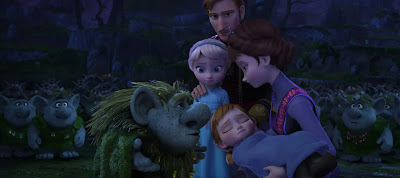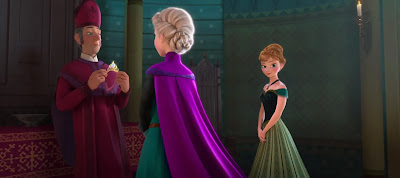Released on November 23rd, 2016, Moana is the 56th animated feature film produced by Walt Disney Animation Studios. Directed by Ron Clements and John Musker from a screenplay by Jared Bush it tells the story of a young Polynesian princess (voiced by Auli'i Cravalho) who sets out to find the demigod Maui (Dwayne Johnson) in order to reverse a terrible curse that threatens the people of her island village.
After production on The Princess and the Frog wrapped in 2009, directors Clements and Musker pitched three new story treatments to studio head John Lasseter. One of them was centered around the Polynesian demigod Māui, an idea Musker had come up with after learning about Polynesian culture and mythology. Lasseter greenlight the idea and sent the two directors off on a research trip to Fiji, Samoa, and Tahiti so they could learn more about the people and culture of the South Pacific Ocean. On this trip they learned that three thousand years ago the Polynesia people had, all of a sudden, stopped making long-distance voyages to explore other lands. Deciding to shift the focus from Maui (who became a supporting character) to a young daughter of a chief, the two men began forming their fictional story around this event.
Moana hearkens back to the renaissance era Disney films, particularly The Little Mermaid. As both films share the same directors, Ron Clements and John Musker this should come as no surprise. Moana, like Ariel, has an overly protective father and leaves her home to find adventure despite his commands to the contrary. While this kind of plot point has become annoyingly commonplace (in Disney films especially), this films at least gives the father an understandable motivation. He too tried to leave the island as a young man but was shipwrecked and lost his best friend in the attempt.
The main conflict in the film for Moana herself is one of legacy. She wants to honor her fathers wishes and her peoples traditions, but also feels compelled to leave the island in order to save them. This inner crisis is resolved early on, as Moana discovers that her ancestors were seafaring explorers and that she has been chosen by the ocean itself to restore the heart of Te Fiti, which was stolen by Maui as a gift for humankind. The rest of the film focuses on her adventures with Maui and the relationship between the two characters. Maui at first wants nothing to do with Moana but is forced to accompany her on her quest because it is the will of the ocean. Maui goes through a bit of an arc himself. Having been cast aside by is parents as an infant only to be found by the gods and given superhuman powers, Maui has spent most of his life trying to win the favor of human beings. The disastrous consequences of his stealing the heart of Te Fiti, which include loosing his magic fishhook, the source of his power, has shattered his confidence but, with Moana's help, he regains both.
Aside from the overly familiar character drama, my biggest issue with the film is, again, the self aware humor that creeps in here and there. Maui's wisecrack about how wearing a dress and having an animal sidekick makes you a princess, a reference to the cliches in Disney princess movies that it makes no sense for Maui to reference within the universe of the film, is particularly egregious. Also frustrating is the films mythology. For one thing the ocean, which is portrayed as a kind of force of nature with a will of its own, continually interferes in the plot to the point where it becomes a bit of a contrivance. More troubling, from a theological perspective, is the film's climax which establishes that Te Fiti is also Te Kā, the demon who has made the ocean perilous and, slowly over time, poisoned the islands Moana's people live on, and was corrupted into this by Maui rash actions. This makes the gods seemingly subject to the actions of humans and unable to control their own actions.
The film has some beautiful animation, particularly of the ocean. The art design is really vibrant and filled with wonderful details. Particularly impressive are the tattoos that cover Maui's body. Done in traditional hand-drawn animation, the tattoos come to life to display the demigod's past exploits to Moana and also (seeming to have a will of their own) reprimand Maui when he makes bad choices. The music, by Opetaia Foa'i, Mark Mancina, and Lin-Manuel Miranda, is quite strong as well. A rising Broadway star, Miranda injects a lyrical wit into his songs that has not been seen since the days of Howard Ashman during the Disney renaissance. Maui's big number "You're Welcome", in particular, is both clever and wonderfully catchy with lyrics like:
"Kid, honestly I could go on and on
I could explain every natural phenomenon
The tide, the grass, the ground
Oh, that was Maui just messing around"
belted out in rapid succession. Samoan artist Opetaia Foa'i contributes a really authentic Polynesian spirit to songs like "We Know the Way" while veteran composer Mark Mancina provides both a fitting instrumental accompaniment to these songs and contributes a solid orchestral score.
The film features strong voice work all around. Hawaiian actress Auliʻi Cravalho brings a real sense of spunk and energy to Moana while also making the character feel down-to-earth and emotionally vulnerable. Dwayne Johnson, who's Maui bears at least some resemblance, plot wise, to the genie from Aladdin, brings his usual infectious charisma and confident masculinity to the role. Though he's no Robin William's, Johnson may be the most entertaining comedic sidekick in a Disney film since the departed comedian, which is impressive considering that Johnson is not really a comic himself. Temuera Morrison (Jango Fett from Star Wars) and Nicole Scherzinger do a good job in their thankless role as Moana's parents. Rachel House, by contrast, gets to shine as Moana's eccentric grandmother, Tala. Finally, Jemaine Clement makes the most of his limited screen-time to imbue the villainous crab Tamatoa with an exotic and self obsessed personality.
In the end, despite some flaws, Moana is still a pretty fun ride and contains enough lovely animation, well written songs and entertaining comedic material to make it worth your while.
Score: 7/10



















































